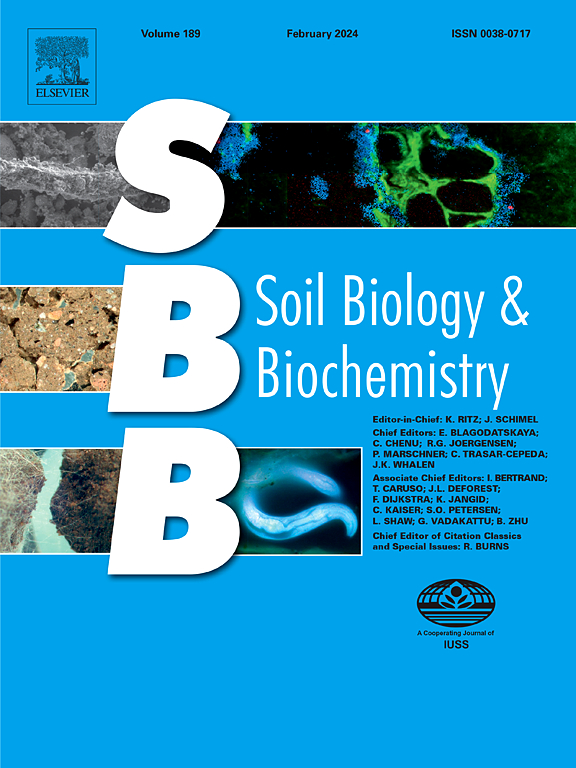全球气候变化使土壤氮矿化和固定化失耦
IF 10.3
1区 农林科学
Q1 SOIL SCIENCE
引用次数: 0
摘要
全球变化因子(gcf)包括CO2 (eCO2)升高、气候变暖、降水(eP)增加、干旱和氮(N)沉积,它们的组合对土壤N循环产生了深刻的影响。尽管进行了广泛的研究,但在理解GCF对土壤N矿化-固定化周转(MIT)的影响方面仍存在重大空白,特别是GCF对总矿化(GM)、固定化(GI)、铵态固定化(GIA)和硝态固定化(GIN)速率的单独和相互作用。我们进行了一项荟萃分析,使用631个成对的实地观察来评估GM、GI、GIA和GIN对单个和联合gcf的反应。结果表明,在检测的单个和组合gcf中,75%对GM有积极作用,12.5%为中性作用,12.5%为阴性作用。相比之下,所有被检查的gcf对GI都没有积极影响,50%没有影响,50%有负面影响。个体gcf对GM的总体影响显著为正(效应量:0.312),而对GI的影响为负(-0.211)。联合gcf对GM有显著的正影响(0.224),对GI有显著的负影响(-0.756)。这些发现首次表明,gcf可能会扩大转基因作物和转基因作物之间的差异,潜在地增加土壤有效氮产量。此外,GI对gcf的响应不如转基因对生态系统、土壤层位和气候带变化的敏感性,这可能是由于GIA和GIN对gcf的响应相反。土壤性质(如pH和总碳)是gcf对GM和GI响应的主要驱动因素,gcf持续时间也被强调用于改善同时gcf下土壤N循环的预测。通过解决土壤N - MIT动态的研究空白,我们的研究结果增强了对未来气候下土壤N有效性及其对生态系统功能的影响的理解。本文章由计算机程序翻译,如有差异,请以英文原文为准。


Global climate changes decoupled soil nitrogen mineralization and immobilization
Global change factors (GCFs), including elevated CO2 (eCO2), warming, increased precipitation (eP), drought, and nitrogen (N) deposition, and their combination have profoundly affected soil N cycling. Despite extensive research, critical gaps remain in understanding GCF effects on soil N mineralization-immobilization turnover (MIT), particularly the individual and interactive effects of GCFs on gross mineralization (GM), immobilization (GI), ammonium immobilization (GIA), and nitrate immobilization (GIN) rates. We conducted a meta-analysis using 631 paired field observations to evaluate the responses of GM, GI, GIA, and GIN to individual and combined GCFs. The results showed that among the examined individual and combined GCFs, 75 % had positive effects on GM, 12.5 % were neutral, and 12.5 % were negative. In contrast, none of the examined GCFs had positive impact on GI, with 50 % showing no effect, and 50 % displaying negative effect. The overall effect of individual GCFs on GM was significantly positive (effect size: 0.312), while their effect on GI was negative (−0.211). Combined GCFs had a significantly positive effect on GM (0.224) but negative effect on GI (−0.756). These findings demonstrate, for the first time, that GCFs may widen the difference between GM and GI, potentially increasing soil available N production. Furthermore, the responses of GI to GCFs showed less sensitivity than that of GM to variations in ecosystems, soil horizons, and climatic zones, likely due to the opposite responses of GIA and GIN to GCFs. Soil properties (e.g., pH and total C) emerged as the primary drivers of GM and GI responses to GCFs, and GCFs duration was also underscored to improve the prediction of soil N cycling under concurrent GCFs. By addressing the research gap in soil N MIT dynamics, our findings enhance the understanding of soil N availability and its implications for ecosystem functioning under future climates.
求助全文
通过发布文献求助,成功后即可免费获取论文全文。
去求助
来源期刊

Soil Biology & Biochemistry
农林科学-土壤科学
CiteScore
16.90
自引率
9.30%
发文量
312
审稿时长
49 days
期刊介绍:
Soil Biology & Biochemistry publishes original research articles of international significance focusing on biological processes in soil and their applications to soil and environmental quality. Major topics include the ecology and biochemical processes of soil organisms, their effects on the environment, and interactions with plants. The journal also welcomes state-of-the-art reviews and discussions on contemporary research in soil biology and biochemistry.
 求助内容:
求助内容: 应助结果提醒方式:
应助结果提醒方式:


